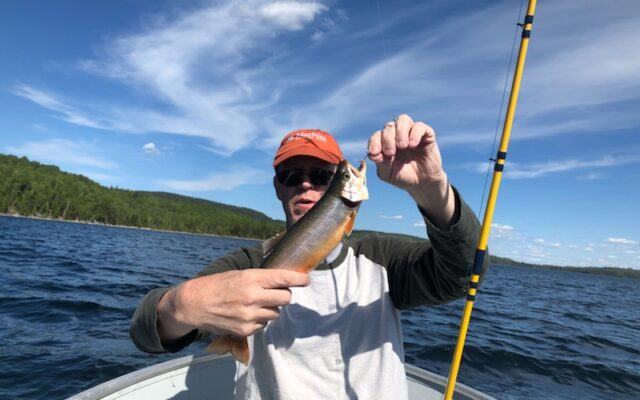
Maine must do more to ensure the survival of rare Arctic charr
By Bob Mallard
We aren’t doing everything we can to ensure the survival of Maine’s Arctic charr, the last fish species of its kind in the contiguous United States. I would say we are working against it.
Previously known as blueback trout, Maine’s Arctic charr are the rarest member of the salmon family east of the Rocky Mountains. Once believed to be related to the fabled Sunapee trout found in New Hampshire and Vermont, DNA testing has determined that they are the same species: Salvelinus alpinus oquassa.
Arctic charr are closely related to brook trout and lake trout. They live longer than the former, and shorter than the latter. Behaviorally, they are closer to lake trout than brook trout.
Aesthetically, they can resemble either, depending on where and when you encounter them. While Arctic charr average less than a foot in length, they can get much larger, including the Maine state record of just more than 25 inches.

Maine is the only place the species can still be found in the continental U.S. In New Hampshire and Vermont, the fish known as Sunapee trout succumbed to non-native lake trout introductions, which hybridized them out of existence.
Maine’s Arctic charr are now the southernmost native populations in the world and are said to be the oldest strains in North America. They were once the primary forage for the large “humpback” brook trout of Rangeley lore. These fish were lost in the early 1900s to angler exploitation and to the introduction of landlocked salmon and smelts, which competed with them for food and space, and preyed on them.
The Endangered Species Committee of the American Fisheries Society classifies Maine’s Arctic charr as “threatened” — a reasonable and prudent position, per the 2015 Wildlife Action Plan. The Maine Department of Inland Fisheries and Wildlife categorizes them as a “Priority 1 Species of Greatest Conservation Need,” a step below threatened.
Maine, once home to 19 Arctic charr waters, has lost more than one-third of those habitats representing more than 75 percent of the total original acreage.
There are now just 12 waters containing wild native Arctic charr: Bald Mountain Pond, Big Reed Pond, Black Pond, Deboullie Pond, Floods Pond, Gardner Pond, Green Lake, Penobscot Lake, Pushineer Pond, Rainbow Lake, Wadleigh Pond and Wassataquoik Lake. There are two non-native populations in Enchanted Pond and Long Pond.
Arctic charr may be threatened in some of those waters due to questionable management practices including stocking of invasive or non-native species and insufficient size and bag limits.
All Arctic charr waters in Maine with the exception of Floods Pond, which is closed to fishing, and the recently reclaimed Wadleigh Pond, are open to harvest with limits of one to five fish.
Length limits are often inadequate, as one water has an 18-inch limit, 10 have slot limits of 10-12 inches (with one fish over that allowed) and six waters have a 6-inch limit, the lowest length limit allowed for salmonids under Maine law.
At least 10 Arctic charr waters allow the use of bait which, by most estimates, comes with a 30-35 percent incidental mortality rate.
Deboullie Lake in 1996 was accidentally stocked by DIF&W with highly invasive non-native landlocked salmon. Fortunately, the fish did not take hold and naturalize.
Big Reed Pond was reclaimed in 2010 due to an invasive smelt infestation. By the time we got around to addressing it, we were only able to trap roughly a dozen brood fish to rebuild the population, raising concerns about their genetic diversity.
Wadleigh Pond was reclaimed in 2012, and for the same reason: highly invasive non-native smelt. Unfortunately, its easy access makes it likely to happen again.
Bald Mountain Pond is now infected with non-native smelt and lake trout, two species associated with the loss of Arctic charr. It appears both are now self-sustaining and, at roughly 1,150 acres, the lake is likely too large to be reclaimed.
Non-native landlocked salmon have found their way into Rainbow Lake. While originally thought to be a single-year class that entered around the same time, and via a compromised dam at the outlet, fish of varying sizes are now being caught, including one salmon over 25 inches. Non-native smelt were first detected in the lake in 1976, and are now self-sustaining.
In 2018, DIF&W reclassified Green Lake as non-native after it was long referred to as a native population. Its position was based on decades old data that indicated the lake had been stocked with charr from Floods Pond at one time. In 2019 it was forced to reverse course as a result of an academic challenge that showed the Green Lake Arctic charr to be more closely related to fish from Wadleigh Pond than Floods Pond.
Green Lake has what DIF&W refers to as a “low abundance” of fish. The lake is being actively stocked with non-native lake trout, the same species blamed for the demise of the Arctic charr in New Hampshire and Vermont. Invasive smallmouth bass also have taken hold, further taxing the fragile Arctic charr population.
Waters connected to Black Pond, Rainbow Lake and Floods Pond are being actively stocked by DIF&W, putting these waters at risk of hatchery borne diseases, viruses, parasites and unintentional non-target introductions. That is likely how the lake trout got into Bald Mountain Pond.
While researching, I came across 1995 and 2015 DIF&W pond survey forms indicating that biologists had encountered what they thought were Arctic charr in Foley Pond. In fact, the DIF&W Species database refers to Arctic charr as “present” in Foley Pond. Unfortunately, nothing has been done to close the loop here.
In 2005, a 20-inch Arctic charr was said to have been caught in Lower Richardson Lake in Rangeley. The angler who caught the fish was a DIF&W Advisory Council member under former Commissioner Ray “Bucky” Owen. Per the angler, DIF&W Game Warden Rick Mills took possession of the fish, which was looked at by DIF&W Regional Biologist Dave Boucher. Well-known fish artist, the late David Footer, painted the fish from a photograph and, when asked, insisted it was an Arctic charr.
While DIF&W never reported the incident, when pushed, it said it was “likely” a drop-down from nearby Long Pond. Unfortunately, no DNA tests were performed to confirm it. The fish would have had to travel more than 15 miles, descend Four Ponds Brook and Bemis Stream, cross Mooselookmeguntic Lake, pass through Upper Dam, and move through Upper Richardson Lake, to get to where it was caught.
That which would be highly unusual for a Maine Arctic charr, and any over 12 inches are rare in Long Pond.